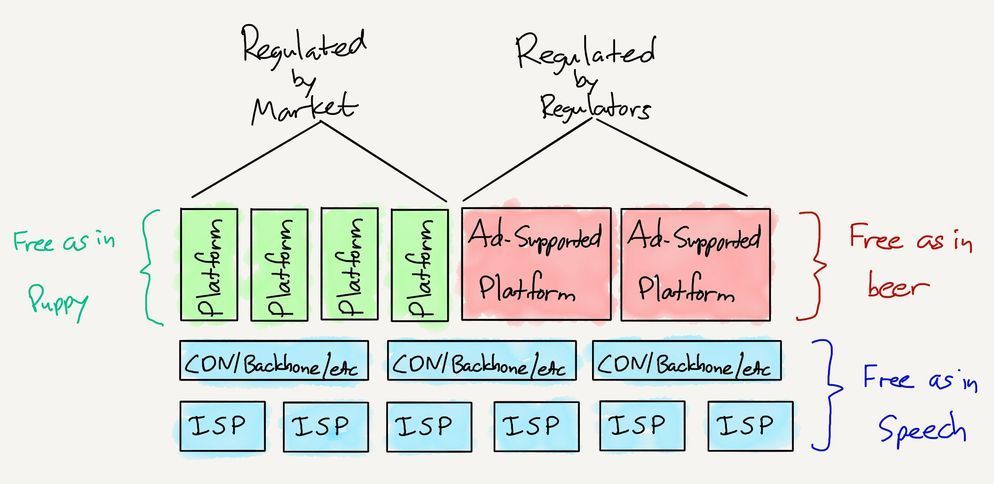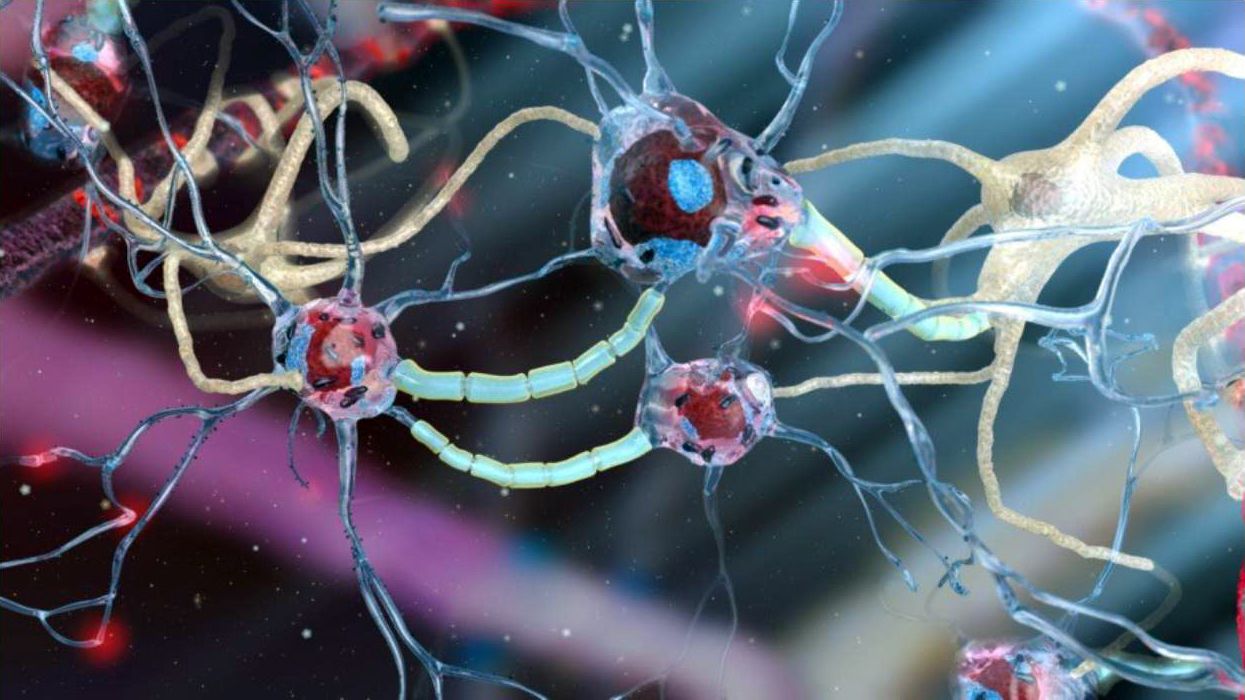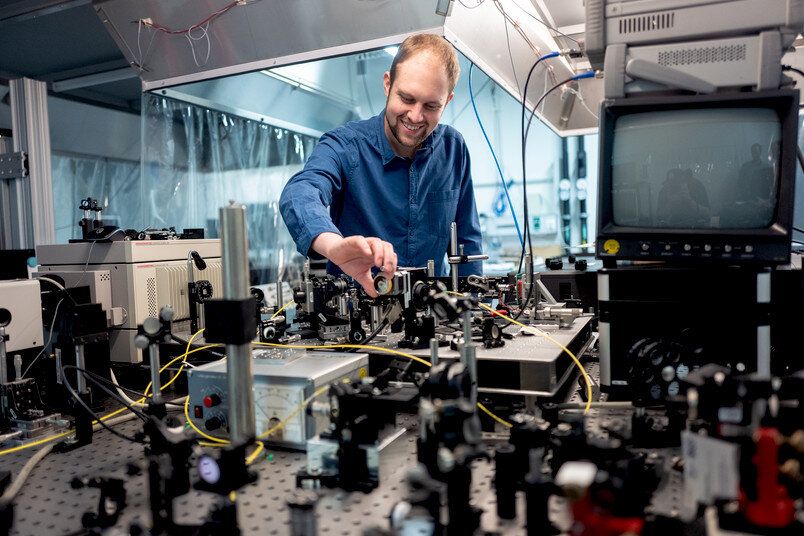Regulators need to stop blindly regulating “the Internet” and instead understand that every part of the Internet stack is different, and only one part is suffering from market failure.



The Internet comprises a decentralized global system that serves humanity’s collective effort to generate, process, and store data, most of which is handled by the rapidly expanding cloud. A stable, secure, real-time system may allow for interfacing the cloud with the human brain. One promising strategy for enabling such a system, denoted here as a “human brain/cloud interface” (“B/CI”), would be based on technologies referred to here as “neuralnanorobotics.” Future neuralnanorobotics technologies are anticipated to facilitate accurate diagnoses and eventual cures for the ∼400 conditions that affect the human brain. Neuralnanorobotics may also enable a B/CI with controlled connectivity between neural activity and external data storage and processing, via the direct monitoring of the brain’s ∼86 × 10 neurons and ∼2 × 1014 synapses. Subsequent to navigating the human vasculature, three species of neuralnanorobots (endoneurobots, gliabots, and synaptobots) could traverse the blood–brain barrier (BBB), enter the brain parenchyma, ingress into individual human brain cells, and autoposition themselves at the axon initial segments of neurons (endoneurobots), within glial cells (gliabots), and in intimate proximity to synapses (synaptobots). They would then wirelessly transmit up to ∼6 × 1016 bits per second of synaptically processed and encoded human–brain electrical information via auxiliary nanorobotic fiber optics (30 cm) with the capacity to handle up to 1018 bits/sec and provide rapid data transfer to a cloud based supercomputer for real-time brain-state monitoring and data extraction. A neuralnanorobotically enabled human B/CI might serve as a personalized conduit, allowing persons to obtain direct, instantaneous access to virtually any facet of cumulative human knowledge. Other anticipated applications include myriad opportunities to improve education, intelligence, entertainment, traveling, and other interactive experiences. A specialized application might be the capacity to engage in fully immersive experiential/sensory experiences, including what is referred to here as “transparent shadowing” (TS). Through TS, individuals might experience episodic segments of the lives of other willing participants (locally or remote) to, hopefully, encourage and inspire improved understanding and tolerance among all members of the human family.
“We’ll have nanobots that… connect our neocortex to a synthetic neocortex in the cloud… Our thinking will be a… biological and non-biological hybrid.”
— Ray Kurzweil, TED 2014


Back in the late 1990s, a traveler from Lebanon to London would have noticed something interesting about telecommunications in the two countries, while many people in Lebanon owned a mobile phone, London was still accustomed to using red telephone boxes to make calls on the run. What caused such a difference? During the Lebanese Civil War, all landline infrastructures were destroyed, and the Lebanese leapfrogged to owning mobile phones. Fast-forward 20 years to today and one can see a similar pattern in many developing countries, where landlines and personal computers are bypassed for mobile internet. 5G is going to make that shift even more dramatic and in many other similar areas, technology is enabling us to bypass existing infrastructure and to rethink the way things are made.
Manufacturing cars is highly efficient and in most 21st century facilities you hardly see any people. Everything is done by robots on a moving assembly line. But it makes you wonder if such a factory setup would make sense for new product categories, which in the beginning are a novelty at best? For example, flying cars or Unmanned Aerial Vehicles ( UAV). The questions we should be asking: How are we going to do it cost-effectively and with similar automation as automotive factories? And can Additive Manufacturing help these novel product categories excel, cut costs and completely skip the assembly line altogether? Just like when Henry Ford created the first moving assembly line back in 1913, it was then a necessity for industrial production to take place. If we wish to cut costs, simplify assembly, reduce factory footprints and part counts, Additive Manufacturing starts becoming a necessity and as a result, we can start questioning the 100-year-old assembly line.

Engineers at Ruhr-Universität Bochum have developed a novel concept for rapid data transfer via optical fibre cables. In current systems, a laser transmits light signals through the cables and information is coded in the modulation of light intensity. The new system, a semiconductor spin laser, is based on a modulation of light polarisation instead. Published on 3 April 2019 in the journal Nature, the study demonstrates that spin lasers have the capacity of working at least five times as fast as the best traditional systems, while consuming only a fraction of energy. Unlike other spin-based semiconductor systems, the technology potentially works at room temperature and doesn’t require any external magnetic fields. The Bochum team at the Chair of Photonics and Terahertz Technology implemented the system in collaboration with colleagues from Ulm University and the University at Buffalo.
Rapid data transfer is currently an energy guzzler
Due to physical limitations, data transfer that is based on a modulation of light intensity without utilizing complex modulation formats can only reach frequencies of around 40 to 50 gigahertz. In order to achieve this speed, high electrical currents are necessary. “It’s a bit like a Porsche where fuel consumption dramatically increases if the car is driven fast,” compares Professor Martin Hofmann, one of the engineers from Bochum. “Unless we upgrade the technology soon, data transfer and the Internet are going to consume more energy than we are currently producing on Earth.” Together with Dr. Nils Gerhardt and Ph.D. student Markus Lindemann, Martin Hofmann is therefore researching into alternative technologies.

“Why are we impatient? It’s a heritage from our evolution,” says Marc Wittmann, a psychologist at the Institute for Frontier Areas of Psychology and Mental Health in Freiburg, Germany. Impatience made sure we didn’t die from spending too long on a single unrewarding activity. It gave us the impulse to act.
Not long ago I diagnosed myself with the recently identified condition of sidewalk rage. It’s most pronounced when it comes to a certain friend who is a slow walker. Last month, as we sashayed our way to dinner, I found myself biting my tongue, thinking, I have to stop going places with her if I ever want to … get there!
You too can measure yourself on the “Pedestrian Aggressiveness Syndrome Scale,” a tool developed by University of Hawaii psychologist Leon James. While walking in a crowd, do you find yourself “acting in a hostile manner (staring, presenting a mean face, moving closer or faster than expected)” and “enjoying thoughts of violence?”
Slowness rage is not confined to the sidewalk, of course. Slow drivers, slow Internet, slow grocery lines—they all drive us crazy. Even the opening of this article may be going on a little too long for you. So I’ll get to the point. Slow things drive us crazy because the fast pace of society has warped our sense of timing. Things that our great-great-grandparents would have found miraculously efficient now drive us around the bend. Patience is a virtue that’s been vanquished in the Twitter age.


Want one more option for home internet? Today it was announced that Amazon is planning to launch 3,236 satellites to build a network to provide global high-speed internet. Unlike current satellite internet, these devices will be in a far lower orbit and offer far faster speeds compared to current sa…

It is a crazy thought, right?! To think that mushrooms could be alien life. But before you dismiss the idea, take a look at some of principles of the theory. The main concept was formulated by the ingenious psychonaut philosopher Terrence McKenna, and goes along following lines.
Like no other form of life on our planet, the spores of mushrooms are almost perfectly suited to space travel. They can survive high vacuum and insanely low temperatures; the casing of a spore is one of the most electron dense materials in nature, to the point where McKenna says it is almost akin to a metal; global currents are even able to form on the quasi-metallic surface of an airborne spore, which then acts as a repellent to the extreme radiation of space. It is a mind boggling thought that something could evolve to be so perfectly suited to explore the universe.
If a civilization is advanced enough, then chances are their concepts and understanding of reality would far outweigh ours. If they were advanced enough to be able to change their very genetic structure, then there would be a lot of merit in changing/evolving into a mushroom. Mushrooms are highly resilient, non-invasive, practically immortal, full of neurotransmitters, and able to weather space. It would be the perfect way to explore and colonize the galaxy. Plus once mushrooms establish themselves, they create an underground neural network of mycelium that highly resembles the neural networks of the human brain or the internet.
